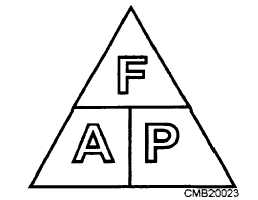Since area equals force divided by pressure, the formula for area is written as follows: A = F divided by P
Figure 3-1 shows a memory device for recalling the different variations of the formula. Any letter in the triangle may be expressed as the product or quotient of the other two, depending on its position within the triangle.
Incompressibility and Expansion of Liquids
For all practical purposes, fluids are incompressible. Under extremely high pressures: the volume of a fluid can be decreased somewhat, though the decrease is so slight that it is considered to be negligible except by design engineers.
Liquids expand and contract because of temperature changes. When liquid in a closed container is subjected to high temperatures, it expands and this exerts pressure on the walls of the container; therefore, it is necessary that pressure-relief mechanisms and expansion chambers be incorporated into hydraulic systems. Without these precautionary measures, the expanding fluid could exert enough pressure to rupture the system.
Transmission of Forces through Liquids
When the end of a solid bar is struck, the main force of the blow is carried straight through the bar to the other end (fig. 3-2, view A). This happens because the bar is rigid. The direction of the blow almost entirely determines the direction of the transmitted force. The more rigid the bar, the less force is lost inside the bar or transmitted outward at right angles to the direction of the blow.

Figure 3-1. - Device for determining the arrangement of the force, pressure, and area formula.

Figure 3-2. - Transmission of force: (A) Solid; (B) Fluid.
When a force is applied to the end of a column of confined liquid (fig. 3-2, view B), it is transmitted straight through the other end and also undiminished in every direction throughout the column - forward, backward, and sideways - so that the containing vessel is literally tilled with pressure.
An example of this distribution of force is shown in figure 3-3. The flat hose takes on a circular cross section when it is filled with water under pressure. The outward push of the water is equal in every direction.
Pascal's Law
The foundation of modern hydraulics was established when Blaise Pascal, a French scientist,

Figure 3-3. - Distribution of force.
Continue Reading